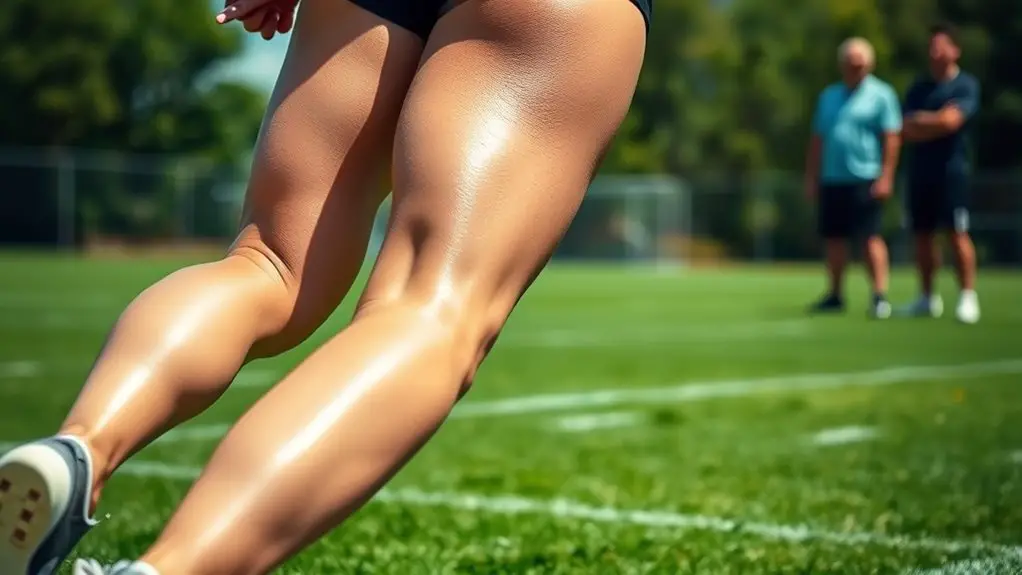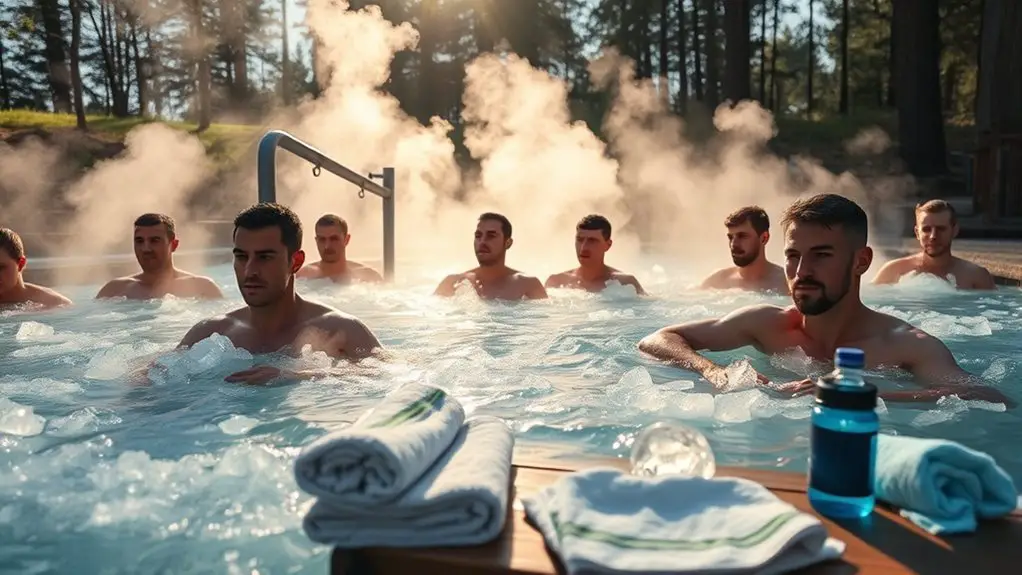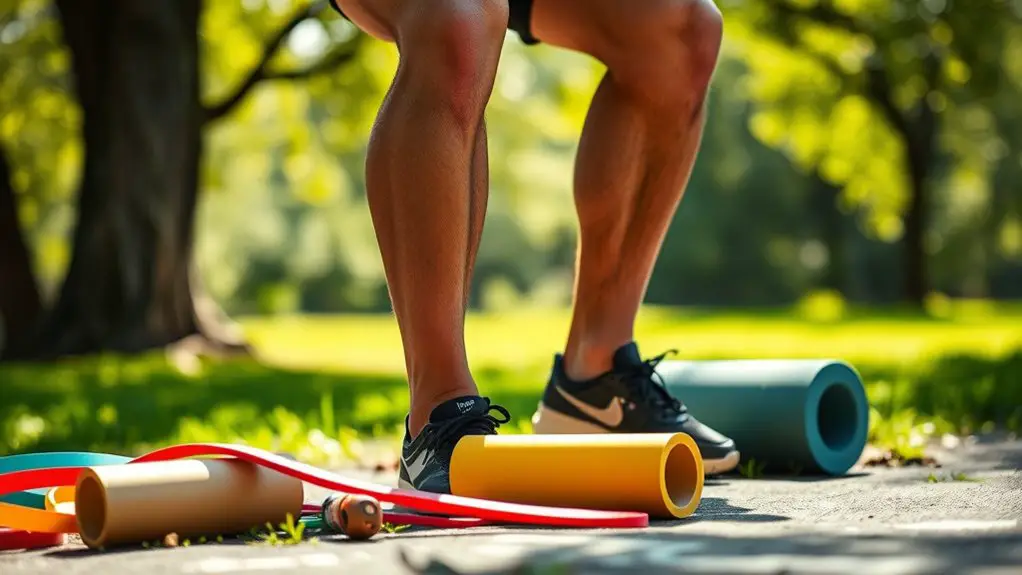Massage therapy boosts your post-game recovery by enhancing blood circulation, which helps deliver nutrients to your muscles and flush out toxins. It reduces muscle tension and soreness, allowing for quicker recovery and improved flexibility. Additionally, it promotes mental relaxation, helping you unwind after the pressures of competition. By identifying tightness and imbalances, massage also plays an essential role in injury prevention. Discover how personalized techniques can take your recovery to the next level.
The Physiological Benefits of Massage Therapy
When you think about post-game recovery, massage therapy often comes to mind as a key player in enhancing your physical well-being. It's not just about feeling good; it's about optimizing your body's potential. Through various relaxation techniques, massage helps to increase muscle elasticity, making your muscles more resilient and less prone to injury. You'll find that the deep pressure and soothing strokes work wonders in releasing tension and enhancing flexibility.
As you unwind, your body also benefits from the release of endorphins, which can elevate your mood and help you feel more at ease. By incorporating massage therapy into your recovery routine, you're not only addressing soreness but actively promoting your body's natural healing process. This freedom to move and perform without restraint can transform your post-game experience, leaving you energized and ready for the next challenge. Embrace the power of massage and let your body thrive! Additionally, effective hydration strategies, such as consistent water intake, are essential for maximizing recovery outcomes.
How Massage Enhances Blood Circulation
Massage therapy considerably boosts blood circulation, which means your muscles get better nutrient delivery right when they need it most. This improved flow not only helps with recovery but also speeds up the removal of waste products from your body. As a result, you'll feel more refreshed and ready for your next game.
Improved Nutrient Delivery
While athletes often push their bodies to the limit during competition, the role of massage therapy in enhancing blood circulation can't be overlooked. When you receive a massage, it stimulates your blood flow, promoting better nutrient transport throughout your body. This improved circulation means that essential nutrients reach your muscles and tissues more efficiently, which is vital for peak cellular function. The more effectively your body delivers these nutrients, the quicker you can recover and regain your strength. You'll feel the difference as your muscles receive the fuel they need to heal and grow. By incorporating massage therapy into your post-game routine, you're not just pampering yourself; you're investing in your body's performance and long-term freedom to play.
Faster Waste Removal
Improved blood circulation not only enhances nutrient delivery but also plays an essential role in waste removal from your muscles. After an intense game, your body accumulates lactic acid and other metabolic byproducts that can leave you feeling sluggish. Massage therapy stimulates blood flow, helping to flush out these toxins more efficiently. By increasing circulation, it promotes a faster recovery, allowing you to feel more free and energized for your next challenge. The gentle pressure of massage encourages your body to clear out waste products, reducing soreness and stiffness. So, when you incorporate massage into your post-game routine, you're not just pampering yourself; you're actively supporting your body's natural recovery process and reclaiming your energy.
Reducing Muscle Tension and Soreness
After a tough game, you might notice muscle tightness and soreness settling in. Massage therapy can help alleviate that tension while also enhancing blood circulation, promoting faster recovery. By focusing on these areas, you'll feel more relaxed and ready for your next challenge. Additionally, staying properly hydrated through hydration is key can further support muscle repair and reduce fatigue after intense physical activity.
Alleviating Muscle Tightness
To effectively alleviate muscle tightness, massage therapy plays an essential role in reducing both tension and soreness that often follow intense physical activity. You know how a tight muscle can feel like a weight holding you back. By targeting trigger points through professional massage or self-massage techniques, you can release that built-up tension and restore your freedom of movement. Simply applying pressure to those pesky knots helps unwind the muscles, allowing you to feel more relaxed and agile. Don't underestimate the power of self-massage; even a few minutes of focused attention can work wonders. Embrace the relief that comes from easing muscle tightness, and you'll be ready to tackle your next challenge with renewed vigor.
Enhancing Blood Circulation
When you engage in intense physical activity, your body craves effective recovery methods, and enhancing blood circulation is one of the best ways to reduce muscle tension and soreness. By increasing blood flow, you deliver essential nutrients and oxygen to your muscles, promoting healing and rejuvenation. Improved circulation also helps flush out metabolic waste, like lactic acid, that can contribute to soreness.
Additionally, massage therapy can greatly boost muscle elasticity, allowing your muscles to return to their ideal state more quickly. As you experience greater freedom of movement, you'll find that your body feels lighter and more agile. Embracing these recovery techniques not only enhances your performance but also supports your overall well-being, empowering you to achieve your fitness goals.
The Role of Massage in Injury Prevention
Although you might think of massage therapy primarily as a tool for relaxation, it plays an essential role in injury prevention for athletes. By incorporating regular massage into your routine, you're taking proactive measures to maintain your body's health and flexibility. Skilled therapists can conduct an injury assessment, identifying tightness or imbalances that may lead to injuries down the line.
When muscles are relaxed and tension is released, you're less prone to strains and sprains. Massage enhances circulation, delivering oxygen and nutrients that promote healing and strengthen tissues. Additionally, it can improve your overall range of motion, allowing you to perform at your best. Furthermore, regular massage can complement proper warm-ups and stretching, which are crucial for preventing injuries.
Mental Recovery: Stress Relief Through Massage
After focusing on the physical aspects of recovery, it's important to recognize how massage therapy also contributes to mental well-being. You might not realize it, but a good massage can be your escape from the pressures of competition. As the therapist works on your muscles, you're not just releasing tension; you're also allowing your mind to unwind.
Incorporating mindfulness techniques during your session can enhance this experience. By focusing on your breath and being present, you create a space for emotional balance. This mental clarity can help you reset after a tough game, letting go of stress and negative thoughts. Additionally, utilizing breathing techniques can further lower your heart rate and enhance your focus during the massage.
Moreover, massage promotes the release of endorphins, which can elevate your mood and foster a sense of freedom. So, as you prioritize your physical recovery, don't overlook the incredible benefits massage therapy offers for your mental fortitude. Embrace this holistic approach to guarantee you're recharged in every way.
Different Types of Massage Techniques for Athletes
When it comes to recovery, understanding various massage techniques can make a big difference for you as an athlete. Deep tissue massage can help relieve tension in your muscles, while sports massage techniques are specifically designed to enhance performance and recovery. Knowing how each technique works can help you choose the best approach for your post-game needs.
Deep Tissue Benefits
While athletes often push their bodies to the limit, incorporating deep tissue massage into their recovery routine can greatly enhance performance and alleviate muscle tension. This technique targets deeper layers of muscle, breaking down knots and improving circulation. You'll find that with regular sessions, your muscle flexibility increases, allowing for better movement and agility during your next game. Deep tissue massage also helps in reducing recovery time, letting you get back to what you love faster. Plus, it's a fantastic way to unwind and connect with your body after intense training. So, if you're looking to elevate your game and feel more liberated in your movements, consider adding deep tissue massage to your arsenal of recovery tools.
Sports Massage Techniques
In addition to deep tissue massage, athletes can benefit from a variety of sports massage techniques tailored to their specific needs. Trigger point therapy targets tight knots in your muscles, while myofascial release helps alleviate tension in the fascia. Incorporating sports stretching enhances flexibility and prepares your body for action. Active release techniques can free up tight muscles, promoting better movement. Compression techniques are great for reducing swelling and accelerating recovery. These methods should align with your recovery protocols and involve muscle reeducation to restore peak function. Always provide athlete feedback to your therapist, ensuring each session meets your unique demands. This personalized approach helps you feel freer and perform better on the field.
Timing: When to Incorporate Massage Into Recovery
Although many athletes may be enthusiastic to jump into massage therapy immediately after a game, timing can greatly impact its effectiveness for recovery. It's crucial to find the right moment to incorporate massage into your routine for best results.
Consider the following points:
- Post-Game Timing: Wait at least 30 minutes after the game before getting a massage. This allows your body to cool down and reduces the risk of injury.
- Recovery Window: Aim for a massage within 24 hours post-game. This is when your muscles can benefit the most from the treatment.
- Pre-Game Massage: Don't forget about the benefits of a pre-game massage. It can help loosen up your muscles and enhance your performance. Additionally, incorporating rest days into your training program is essential for maximizing recovery and preventing burnout.
The Science Behind Massage and Muscle Repair
Understanding how massage therapy aids muscle repair can enhance your recovery strategy. The recovery science behind massage reveals how it promotes blood flow, reduces muscle tension, and accelerates healing. Here's a quick breakdown:
| Benefit | How It Helps | Recovery Impact |
|---|---|---|
| Increased Blood Flow | Delivers nutrients to muscles | Speeds up muscle repair |
| Reduced Muscle Tension | Eases soreness | Enhances flexibility |
| Improved Lymphatic Function | Flushes out toxins | Reduces inflammation |
| Enhanced Relaxation | Lowers stress levels | Promotes overall recovery |
| Pain Relief | Alleviates discomfort | Boosts performance readiness |
Incorporating techniques like foam rolling into your routine can complement the benefits of massage therapy, enhancing your body's ability to recover effectively. When you incorporate massage into your routine, you're not just pampering yourself; you're actively investing in your body's ability to repair and recover. Embrace the freedom that comes from effective recovery and let massage therapy be your ally in achieving peak performance.
Personalizing Massage Therapy for Individual Needs
When it comes to recovery, tailoring massage therapy to your specific needs can make all the difference. By incorporating tailored techniques that resonate with your individual preferences, you can enhance your post-game recovery experience. Here's how you can personalize your massage therapy:
- Targeted Areas: Focus on sore muscles or areas prone to injury, ensuring you're addressing your unique concerns.
- Pressure Preferences: Communicate whether you prefer deep tissue work or lighter, more relaxing strokes—it's all about what feels best for you.
- Timing and Frequency: Decide how often you want sessions and when they fit best into your routine, giving you the freedom to choose.
Integrating Massage Therapy Into Athletic Training Regimens
As you look to enhance your athletic performance, integrating massage therapy into your training regimen can be a game-changer. It's not just about physical strength; it's about recovery and flexibility too. By collaborating with your team of trainers and therapists, you can design personalized recovery schedules that fit your unique needs.
Massage therapy can help alleviate muscle tension, prevent injuries, and promote overall well-being, allowing you to stay in peak condition. Consider scheduling regular sessions during your training cycles, ensuring that recovery is a priority. Additionally, incorporating recovery technology can further optimize your post-game recovery process.
This proactive approach not only enhances your performance but also fosters a culture of care within your team. When everyone's on the same page, you'll find that recovery becomes more efficient and enjoyable. So, embrace the freedom that comes with a well-rounded training regimen and let massage therapy be an essential part of your athletic journey.
Frequently Asked Questions
Can Massage Therapy Be Used for Non-Athletic Recovery?
Absolutely, massage therapy can be a game-changer for non-athletic recovery. Whether you're dealing with stress, muscle tension, or just seeking general wellness, it can help you unwind and rejuvenate. You'll find that regular sessions can enhance your overall sense of freedom and relaxation. So, if you're looking to recharge after a long week or simply want to treat yourself, consider incorporating massage therapy into your self-care routine—it's definitely worth it!
How Often Should Athletes Receive Massage Therapy?
Think of your muscles as a well-tuned engine; they need regular maintenance to perform at their best. For athletes, frequency recommendations often suggest a massage once a week for ideal timing, especially during intense training phases. However, listen to your body—if you're feeling tight or sore, don't hesitate to sneak in an extra session. Embracing this freedom in your routine can help you stay sharp and ready for the next challenge.
Are There Any Risks Associated With Massage Therapy?
Yes, there are some risks associated with massage therapy. You need to be aware of contraindications, like certain medical conditions or injuries that might make massage unsafe for you. It's also essential to take into account potential allergies to oils or lotions used during the session. Always communicate openly with your therapist about your health history and any concerns you have, so you can enjoy the freedom of massage without unnecessary risks.
What Should Athletes Communicate to Their Massage Therapist?
When you're heading to a massage therapist, it's essential to communicate openly. Share your athlete preferences regarding pressure and techniques you enjoy. Don't forget to discuss your injury history, as this helps the therapist tailor the session to your needs. Being honest about how you feel during the massage can enhance your experience and guarantee you're getting the most benefit. After all, it's about your comfort and recovery!
Can Massage Therapy Help With Mental Health Issues?
Did you know that about 60% of people experience stress regularly? Massage therapy can certainly help with mental health issues by promoting stress relief and enhancing emotional well-being. When you receive a massage, it triggers the release of endorphins, which can lift your mood and reduce anxiety. If you're seeking a sense of freedom from daily pressures, incorporating massage into your routine might be just what you need to feel more balanced and relaxed.




